Trace Fossils
Trace Fossils
Ichnological Principles
Same Species Different Structures
Same Burrow Different Substrates
Different Tracemakers
Identical Structures
Multiple Individuals Single
Structure
Burrowing Organisms Low
Preservation
Open Burrow High
Preservation Potential
Types of Traces
Classification Principles
Behavioural Classification
Preservational Classification


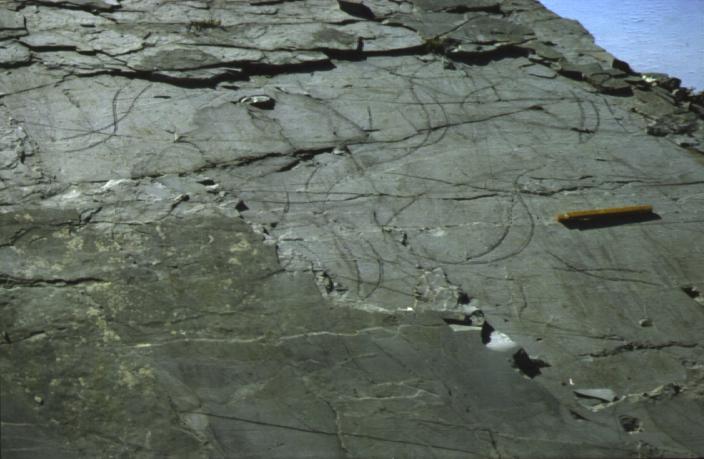
Ichnological Principles
Biogenic sedimentary structures do not represent the burrowing animals themselves, but show their behaviour. Each trace fossil tends to be attributed to its trace-making organism, but they can tell more interesting things than the name of the "architect".
Here are the basic ichnological principles:
1.Same Species Different Structures
1.The same species can produce different structures corresponding to different behaviour patterns

The modern fiddler crab Uca produces a:
- J-shaped living burrow (Psilonichnus domichnion - 1),
- a walking (repichnia) trail (Diplichnitesrepichnion - 2),
- a radiating grazing trace with balls of processed sand(pascichnion - 3),
- and faecal pellets (coprolites - 4) - (after Benton & Harper 1997)
2.Same Burrow Different Substrates
2.The same burrow may be differently preserved in different substrates according to the average grain size, sediment stability, water content, and chemical conditions in sediment.
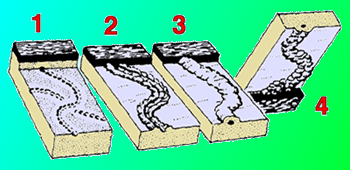
A subsurface patch-feeding burrow develops different morphologies, and therefore has different names, when
- preserved in sand (Scalarituba - 1),
- at a sand-mud interface in firm sediment(Nereites - 2),
- at a sand-mud interface in wetter sediment (Neonereites - 3),
- and at a mud-sand interface, seen from below(Neonereites - 4)
3.Different Tracemakers Identical Structures
3.Different tracemakers with similar behaviour may produce identical structures.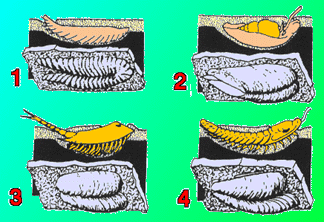
Resting traces (cubichnia) of the ichnogenus Rusophycus, produced by a
- polychaete worm (1),
- a nassid snail (2),
- a notostracan branchiopod shrimp (3),
- and a trilobite (4)
4.Multiple Individuals Single Structure
4.Multiple individuals may produce a single structure.5.Burrowing Organisms Low Preservation
5.The burrowing organisms usually have a low potential of preservation as body fossils.
A bivalve mollusc preserved as a mold into a network of burrows (Osmington Mills, Dorset - photo M.A. Kaminski)
6.Open Burrow High Preservation Potential
6.The open burrow is an environment with a higher preservation potential than the rest of the sea floor in general, protecting the fallen in skeletons against the most destructive phases of early diagenesis.
Trace fossils are hard to be connected to the zoological taxonomical system and must be treated according to the ichnological principles.
Types of Traces
There are many kinds of trace fossils and also a variety of cryptic fossils and sedimentary structures that may be regarded as trace fossils. The main trace fossil types belong to four main groups:Traces on bedding planes
Tracks - sets of discrete footprints, usually formed by arthropods and vertebrates
Trails - continuous traces, usually formed by the whole body of a traveling or resting worm, mollusc or arthropod
Structures within the sediment
Burrows - structures formed within soft sediment by moving grains out of the way, either for locomotion, dwelling, protection or feeding
Borings - structures formed in hard substrate by cutting right through the grains, either for protection, dwelling, carbonate extraction or even for feeding purpose (bioerosion drill holes in shells).
Excrements
Faecal pellets and faecal strings - small pellets or strings of excrement, usually of less than 10 mm length
Coprolites - discrete faecal masses produced by vertebrates, usually more than 10 mm length
Others
Root penetration structures - impressions of activity of growing roots
Non-faecal pellets - regurgitation pellets of vertebrates, excavation pellets of crustaceans
Many ichnologists might also include other biological interactions with sediments as trace fossils, such as stromatolites, some mud mounds, dinosaur nests, etc.
Classification Principles
Trace fossils can be classified according to Linnaean taxonomy, ethology (inferred life history and behaviour of trace producing organisms), or preservational type.Linnaean classification involves the using of a binomial system similar to that employed for body fossils and living species.
Ichnotaxa include ichnogenera and ichnospecies, simply used to define morphological differences.
In many cases is difficult to prove a direct relationship between trace producer and trace (e.g.. the trace produced by the genus Lithophaga is called, according to its shape, Gastrochaenolites), therefore is
desirable an independent name for a particular trace morphology.
Ethological (Behavioural) classification is a mechanism of distinguishing groups of traces on the basis of the behaviour of a group of organisms.
The main types include:
resting traces - cubichnia - created by active organisms while at rest or hiding from prey;
locomotion traces - repichnia - tracks and trails created while moving across the sediment surface;
dwelling traces - domichnia - three dimensional dwelling structures created by burrowing;
grazing traces - pascichnia - horizontal feeding traces on the surface of the substrate;
feeding traces - fodinichnia - three dimensional networks characterized by the combined functions of deposit feeding and dwelling.
traps and gardening traces - agrichnia - regular, patterned branching structures used as traps for migrating meiofauna or as gardening systems where microbes might be cultured for food.
predation traces - praedichnia - are common on hard substrates, as round drill holes in shells and shell damage by predators.
equilibrium traces - equilibrichnia - are characterized by burrows that must be constantly adjusted within the substrate due the agradation and degradation processes.
escape traces - fugichnia - occur as the animal flees to the new sea floor
edifices built above the substrate - aedificichnia - are structures built of sediment, more or less cemented by the architect
structures made for breeding purposes - calichnia - are structures built for raising larvae and juveniles.
Behavioural Classification
Major categories of trace fossils according to behavioural classification and some illustrated ichnogenera:
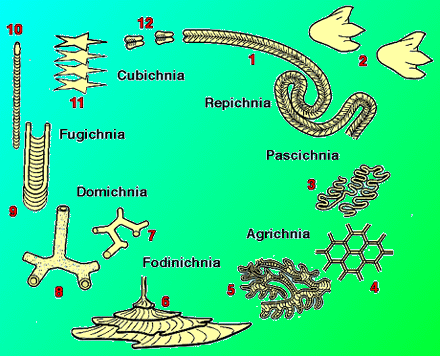
- 1.Cruziana;
- 2. Anomoepus;
- 3. Cosmorhaphe;
- 4.Paleodictyon;
- 5. Phycosiphon;
- 6. Zoophycos;
- 7. Thalassinoides;
- 8. Ophiomorpha;
- 9. Diplocraterion;
- 10. Gastrochaenolites;
- 11. Asteriacites; Rusophycus
Preservational Classification
Preservational classification uses the relationship of the trace with the sedimentary surface.
According to this criterion the traces can be exogenic (on the sediment surface) or endogenic (within the sediment itself).
Traces can be found in full relief (with the boundaries of circular burrows clearly defined within the enclosing sediment) or semirelief,
either on the upper surface (epirelief), or on the lower surface (hyporelief) of a sedimentary layer.
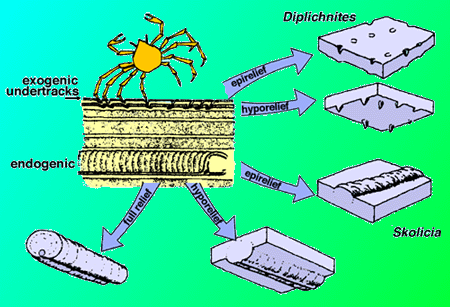
Terminology of trace fossil preservation depending on the relationship to sediment horizons (after Benton & Harper, 1997)

